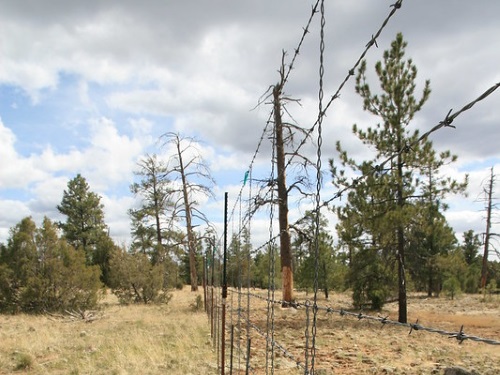The Arizona Department of Transportation recently highlighted the benefits of its collaboration with the Arizona Game & Fish Department (AZGFD) to reduce elk-vehicle crashes on northbound I-17 south of Flagstaff in a blog post.
[Above photo by Arizona DOT]
In 2011, AZGFD noted a high number of elk-vehicle crashes occurred along a stretch of I-17 near Munds Park. Because a full-grown bull elk can weigh upwards of 700 pounds, crashing into something that large can destroy a vehicle and cause serious injury or death to vehicle occupants, as well as the animal.
In 2012, after a series of studies, AZGFD and the Arizona DOT installed ungulate – “ungulate” means “hoofed mammal” – fencing in four locations near Munds Park on I-17. In most instances, Arizona DOT works crews modified existing right-of-way fences with bolts and barbed wire, eliminating the need for completely new fencing and poles.
This project produced almost immediate results, both agencies said. From the 20 documented elk-vehicle crashes that occurred along this strip of I-17 from 2007 to 2010, only one occurred between 2010 and 2014.
Arizona DOT said this is but one example of the state mitigating wildlife issues through partnerships among multiple agencies. The agency noted it also collaborated with AZGFD to construct wildlife underpasses and elk crossings along State Route 260 east of Payson and desert bighorn sheep overpasses near historic Hoover Dam on US 93.
The wildlife protection efforts undertaken by Arizona DOT are reflective of similar initiatives spearheaded by state departments of transportation nationwide.
For example, in July and August every year, the North Carolina Department of Transportation temporarily lowers speed limits from 55 mph to 20 mph on the William B. Umstead Bridge – locally known as the old Manns Harbor Bridge – at dusk and dawn during the roosting period of purple martin bird flocks.
NCDOT noted in a statement that it has collaborated with the Coastal Carolina Purple Martin Society since 2007 to educate the public about the purple martin flocks, to protect both the birds and motorists.
Meanwhile, the Colorado Department of Transportation recently completed the state’s newest wildlife overpass and underpass on U.S. Highway 160 in the southwestern part of the state, celebrating the accomplishment with a ribbon-cutting event.
To date, Colorado DOT said it has built more than 60 wildlife mitigation structures crossing above or under highways throughout the state. Additionally, it has installed 400 miles of high big game fencing along state and U.S. highways or next to the interstates.
On the research front, a report released by an international pool funded study led by the Nevada Department of Transportation in July provides an “authoritative review” of the most effective measures to reduce animal-vehicle collisions, improve motorist safety, and build safer wildlife crossings.
With as many as two million collisions with large mammals in the United States leading to approximately 200 human deaths every year, the review compiled, evaluated, and synthesized studies, scientific reports, journal articles, technical papers, and other publications from within the United States and beyond to determine effectiveness of 30 different mitigation measures.
Ultimately, the report provides best management practices to reduce animal-vehicle collisions, increase habitat connectivity, and implement cost-effective solutions, Nevada DOT said.

